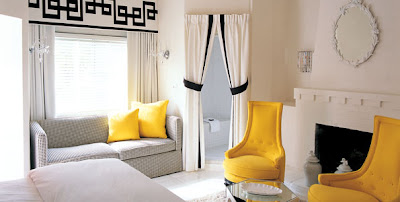
Good House Design
MODEL INTERIOR DESIGN, TRIMMINGS ROOM, INFORMATION ABOUT THE HOUSE
Wednesday, July 28, 2010
White Chic
 Patricia Gray
Patricia GrayUsing white in a room can make it have surprising depth - I use several shades of white to bring out the architectural details in a room, or I layer the space with strong forms in different tones and textures of white and use some strong contrasts to outline and bring the white into focus. Some of my favourite whites I use are: Benjamin Moore - Cloud White, Simply White, Ballet White, Designer White. Not every white is snow white. Try using: ivory, cream, antique white, and palest beige.
Nothing is more chic than WHITE ON WHITE

Patricia Gray
Some white facts from the web:
Ultimate Light: White is purity, cleanliness, and innocence. Like black, white goes well with almost any color.
Culture of White: In most Western countries white is the color for brides. In the East, it's the color for mourning and funerals. Some cultures viewed white as the color of royalty or of deities. Angels are typically depicted as wearing white. In early Westerns the good guy wore white while the bad guy wore black.
Using White: In most cases white is seen as a neutral background color and other colors, even when used in smaller proportion, are the colors that convey the most meaning in a design. Use white to signify cleanliness or purity or softness. Some neutral beige, ivory, and creams carry the same attributes as white but are more subdued, less brilliant than plain white. Use lots of white for a summery look. Use small amounts of white to soften a wintery palette or suggest snow.
Using White with Other Colors: Used with light or pastel tones, white is soft and Spring-like and helps to make the pastel palette more lively. White can make dark or light reds, blues, and greens look brighter, more prominent.
White Words: These words are synonymous with white or represent various shades of the color white.
White Words: These words are synonymous with white or represent various shades of the color white.
pearl
antique white
ivory
chalk
milk white
lily
smoke
seashell
old lace
cream
linen
ghost white
beige
cornsilk
alabaster
paper
whitewash

Elle Decor
 Victoria Hagen
Victoria Hagen 

 Purple Area
Purple Area Lamp by Tobias Wong
Lamp by Tobias Wong- with a coat of white paint even the most traditional forms can be transformed into something altogether new.
 Coat rack by Seattle artist Erich Ginder
Coat rack by Seattle artist Erich Ginder Patricia Gray Regina Chair
Patricia Gray Regina Chair Wing Back chair by Victoria Hagan
Wing Back chair by Victoria Hagan Ghost Chair by Philip Starck
Ghost Chair by Philip Starck John Saladino Porticus Bench
John Saladino Porticus Bench Simplicity interior
If you are like me and so many others with busy lifes and careers, I am always on the search for ways to simplify my life, organize my work, keep on top of things, file information so I can find it when I need it. So when I came across this book I thought maybe it held the answer.

The book Laws of Simplicity offers ten laws for balancing simplicity and complexity in business, technology, and design. But after I had tried to this book, which I found to NOT be a simple read. I have to say it falls under Law #9Failure - some things can never be made simple. Like I am always trying to achieve the simplest of designs which I find are the very hardest, because everything has to be detailed to perfection equates to Law 5 - simplicity and complexity need each other. Sometimes I love the simplest of design and sometimes I am attracted to over the top design. Sometimes simplicity works and sometimes not. Maybe there is something to the adage that "opposites do attract".
Simple things I love: my Ipod, my Blackberry, blogging, designs by Christian Liagre
Complex things I love: travel (getting through security), playing the piano, finding the perfect bottle of wine, designs by Kelly Wearstler
TEN LAWS
Simple things I love: my Ipod, my Blackberry, blogging, designs by Christian Liagre
Complex things I love: travel (getting through security), playing the piano, finding the perfect bottle of wine, designs by Kelly Wearstler
TEN LAWS
1. REDUCE The simplest way to achieve simplicity is through thoughtful reduction.
2. ORGANIZE Organization makes a system of many appear fewer.
3. TIME Savings in time feel like simplicity.
2. ORGANIZE Organization makes a system of many appear fewer.
3. TIME Savings in time feel like simplicity.
4. LEARN Knowledge makes everything simpler.
5. DIFFERENCES Simplicity and compleity need each other.
5. DIFFERENCES Simplicity and compleity need each other.
6. CONTEXT What lies in the periphery of simplicity is definitely not peripheral.
7. EMOTION More emotions are better than less.
8. TRUST In simplicity we trust.
8. TRUST In simplicity we trust.
9. FAILURE Some things can never be made simple.
10. THE ONE Simplicity is about subtracting the obvious and adding the meaningful
10. THE ONE Simplicity is about subtracting the obvious and adding the meaningful

Simple ....but complex


Complex ...but simple
Subscribe to:
Posts (Atom)